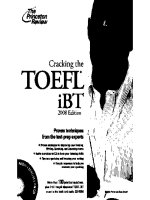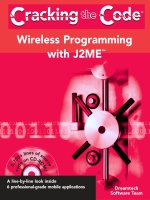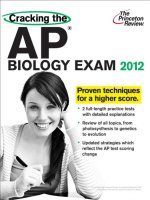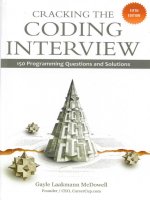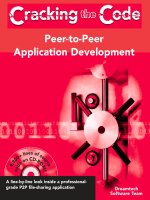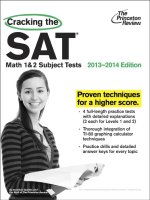Cracking the sat chemistry subj the princeton review
Bạn đang xem bản rút gọn của tài liệu. Xem và tải ngay bản đầy đủ của tài liệu tại đây (7.31 MB, 408 trang )
Editorial
Rob Franek, Senior VP, Publisher
Mary Beth Garrick, Director of Production
Selena Coppock, Senior Editor
Calvin Cato, Editor
Kristen O’Toole, Editor
Meave Shelton, Editor
Random House Publishing Team
Tom Russell, Publisher
Nicole Benhabib, Publishing Director
Ellen L. Reed, Production Manager
Alison Stoltzfus, Managing Editor
The Princeton Review, Inc.
111 Speen Street, Suite 550
Framingham, MA 01701
E-mail:
Copyright © 2013 by Itzy
Cover art © Jonathan Pozniak
All rights reserved under International and Pan-American Copyright Conventions. Published in the United States by Random House, Inc., New York,
and simultaneously in Canada by Random House of Canada Limited, Toronto.
SAT is a registered trademark of the College Board.
The Princeton Review is not affiliated with Princeton University.
eBook ISBN: 978-0-307-94576-1
Trade Paperback ISBN: 978-0-307-94556-3
Editor: Calvin S. Cato
Production Editor: Harmony Quiroz
Production Artist: John E. Stecyk
2013–2014 Edition
v3.1
Acknowledgments
The author thanks Cary West, John Bergdahl, Greta Blau, Cynthia Brantley, Sarah
Brockett, Jessica Brockington, Joseph Cavallaro, Ji Sun Chang, Andrew Dunn, Leland
Elliott, Alicia Ernst, Kristin Fayne-Mulroy, Paul Foglino, Effie Hadjiioannou, Julian Ham,
Adam Hurwitz, Sung (Peter) Jung, Sara Kane, Jason Kantor, Chris Kensler, Martha Link,
Illeny Maaza, Kim Magloire, Robert McCormack, Russell Murray, Jeff Nichols, John C. Pak,
Dinica Quesada, Lisa M. Ruyter, Chris “Short-Hair” Scott, Ramsey Silberberg, Linda
Tarleton, Chris Thomas, Thane Thomsen, Chris Volpe, and P. J. Waters.
Thanks to Kathleen Rocklein for her review of the 2013–2014 edition.
Special thanks to Adam Robinson, who conceived of and perfected the Joe Bloggs
approach to standardized tests and many of the successful techniques used by The
Princeton Review.
Contents
Cover
Title Page
Copyright
Acknowledgments
Part I: Orientation
1
Introduction
What Are the SAT Subject Tests?
What Is The Princeton Review?
Point 1: Learn Chemistry the Way the Subject Test Tests It
Point 2: Approach the Test Strategically
What About Practice and Practice Tests?
Should I Buy Practice Material from ETS?
2
Test Strategies
Cracking the SAT Chemistry Test
Strategy #1: Study the Right Stuff in the Right Way
Strategy #2: Do the Easy Ones First
Strategy #3: Take a Guess!
Strategy #4: Making Associations (Type A, B, and C Questions)
Strategy #5: Rephrase the Question (Type A and C Questions)
Strategy #6: Avoiding the Temptation Trap
Strategy #7: Divide and Conquer
Strategy #8: Process of Elimination
3
Some Basic Stuff
Mass
Volume
Density
Pressure
Energy
Temperature and Specific Heat
How the SAT Chemistry Subject Test Will Test You on All This
Summary
Part II: Subject Review
4
Atoms: The Building Blocks of Matter
Atoms and Elements
The Periodic Table
Summary
5
Chemical Reactions and Stoichiometry
The World of Molecules
The Mole
Chemical Reactions—How Molecules Are Formed, Broken Down, and Reformed
Stoichiometry
Thermodynamics
Summary
6
Electron Configurations and Radioactivity
Orbitals
Electron Configurations
Radioactivity and Half-Lives
Summary
7
The Periodic Table and Bonding
The Periodic Table
Some Important Periodic Trends
Chemical Bonding
Molecular Shapes
Summary
8
Phases: Gases, Liquids, and Solids
Gases
Intermolecular Forces
Phase Changes
Energy and Phase Changes
Summary
9
Solutions
Measuring Concentrations
Boiling Point Elevation and Freezing Point Depression
Precipitation Reactions
Summary
10 Kinetics and Equilibrium
Kinetics
Chemical Equilibrium
Summary
11 Acids and Bases
The Autoionization of H2O
Acids and Bases
Acid-Base Titrations
Summary
12 Redox and Electrochemistry
Oxidation and Reduction
Redox Reactions
Electrochemistry
Summary
13 Organic Chemistry and Environmental Chemistry
Organic Chemistry
Environmental Chemistry
Summary
14 Laboratory
Safety Rules
Accuracy
Significant Figures
Lab Procedures
Laboratory Equipment
You’re Ready!
Summary
Part III: Drill Answers and Explanations
Part IV: The Princeton Review Practice SAT Chemistry Subject Test and
Answers and Explanations
15 Practice SAT Chemistry Subject Test 1
16 Practice SAT Chemistry Subject Test 1: Answers and Explanations
17 Practice SAT Chemistry Subject Test 2
18 Practice SAT Chemistry Subject Test 2: Answers and Explanations
19 Practice SAT Chemistry Subject Test 3
20 Practice SAT Chemistry Subject Test 3: Answers and Explanations
Formula Cheat Sheet
Index
About the Author
Part I
Orientation
1
2
3
Introduction
Test Strategies
Some Basic Stuff
Chapter 1
Introduction
The SAT Subject Tests are one-hour exams that assess a student’s knowledge of a
particular academic subject. Not all colleges require the subject tests, and some subject
tests are more appropriate for certain students than for others. The format and content
of a given test falls within certain guidelines, and you should prepare accordingly. In
this chapter we will answer some basic questions about the SAT Chemistry Subject Test
and how you should prepare for it.
WHAT ARE THE SAT SUBJECT TESTS?
The SAT Subject Tests are a series of tests administered by the Educational Testing
Service (ETS). Unlike the regular SAT, the SAT Subject Tests are designed to measure
knowledge in very speci c areas. Many colleges require that you take one or more of
these tests in order to qualify for admission; but even at colleges that do not require that
you take them, administrators view student performances on the tests as an important
factor that contributes to the decision to grant or withhold admission. Additionally, at
some schools, a high score on one or more of the tests might enable you to “place out” of
certain required college courses. For example, if you do well on the SAT Chemistry
Subject Test, you might be exempt from ful lling the science requirement at one or more
of the schools to which you’re applying!
Which SAT Subject Tests Should I Take?
The colleges that do require you to take the SAT Subject Tests will expect you to take
two or three of them. In order to nd out which tests are required by the colleges to
which you’re applying, you can ask your guidance counselor, call the admissions o ce
of the colleges, or check in college guidebooks. Alternately, you can visit the College
Board website at sat.collegeboard.org and use their college search engine to look up
the colleges you’re interested in; each school on this search engine has a pro le in which
this information is provided.
Once you nd out which, if any, tests are required, part of your decision making is
done. The next step is to nd out which of the tests will show your particular strengths.
After all, the SAT Subject Tests are given in a variety of subjects: Literature, U.S.
History, World History, Biology, Chemistry, Physics, French, German, Spanish, Modern
Hebrew, Italian, Latin, Japanese, Korean, Chinese, and English Language Pro ciency.
You should take the tests on which you think you’d score the highest. If you’re uent in
Chinese, take the SAT Chinese Test. If, however, you’re most comfortable in the world of
moles, atoms, and titrations, take the SAT Chemistry Test.
When Are the Tests Offered, and How Do I Register for Them?
The SAT Subject Tests are usually administered in October, November, December,
January, May, and June at test centers around the country. Since not all of the tests are
o ered at each administration, be sure to check the dates and details on the College
Board website carefully. You’ll want to take the test on a date that’s as close as possible
to the end of your coursework in the subject. For example, if your chemistry course ends
December 21, take the January test. If it ends in May, take the test in May or June—
whichever date falls the soonest after your course has ended.
You can register for these tests either through the College Board website or through
regular mail. To register by mail, ask your guidance counselor for the appropriate
forms, which you’ll need to mail in by the date listed on the College Board website—
generally about ve weeks before the test. You can register late, but late registration
ends about four weeks prior to the test week and will cost you an additional fee. The
costs of registering for an individual SAT Subject Test are $21 for the rst test and $10
for any additional test.
You’ll need to arrive at the test center pretty early—by 8:15 A.M. Your rst test will
begin promptly at 8:30 A.M., and since each test is an hour long, if you take the
maximum of the three tests that you’re allowed to take at each sitting, you’ll be done by
12:30 P.M. If you’re taking just one or two tests, you can leave as soon as you’ve finished.
One nal, but important, note—ETS allows you to change your mind about what test
you’d like to take on the test day. This means that if you aren’t sure which test you’ll feel
more con dent taking, you can study up until test day and then make your decision at
the last moment.
How Is the Test Scored, and What Does the Score Mean?
As with the regular SAT, the SAT Subject Tests are scored on a scale from 200 to 800,
where 200 is the lowest and 800 is the highest; the exception to this rule is the English
Language Proficiency Test, which is scored on a scale from 901 to 999.
Subject tests that do not involve written responses (such as the SAT Chemistry) are
graded by a computer. The computer simply adds up the number of questions you
answered correctly and subtracts from this number one-quarter of the number of
questions you answered incorrectly. (It doesn’t count questions that you skipped either
way.) This determines your raw test score. The raw score is then converted to a scaled
score.
So, what’s a good score on the SAT Chemistry? Well, a good score is one that falls in or
above the range that the colleges you are interested in state as desirable. On the scale
from 200 to 800, 500 is considered the average score of all test takers. If you score
higher than this, your performance on the test is above average—if you score lower,
then your performance is below average. Along with your regular score, you’ll receive a
percentile rank; this is another indication of how you fared in relation to all of the other
test takers. If you receive a percentile ranking of 60 percent, that means that you scored
higher than did 60 percent of test takers and lower than 40 percent of test takers. But
keep in mind that even if your score is below average or below the range that the
schools of your choice list as being desirable for entrance, this doesn’t necessarily mean
that you won’t get into these schools. Your scores on the SAT Subject Tests are not the
only factor that goes into the admissions decision.
A Couple of Words About Score Choice™
As of March 2009, you can choose which SAT Subject Test (and regular SAT) scores you
want colleges to see by using Score Choice™. This is great news! So if, for example, you
take the French test followed by the Chemistry test, but don’t think the Chemistry test
went very well, you can simply opt to have that Chemistry score withheld from the
schools to which you are applying.
Score Choice is optional for students—this means that you have to opt in and actively
choose which speci c tests you want to send to colleges. If you choose not to use Score
Choice, then all of the scores on le for you will automatically be sent when you request
that score reports be sent to the colleges you’re applying to.
If you decide not to use Score Choice, all of your scores will be sent to your recipients.
Students should still feel comfortable sending all scores, since most colleges consider a
student’s best score.
A searchable list of colleges and their requested SAT score submission requirements, as
well as more information on Score Choice, can be found at the College Board website at
www.collegeboard.com.
When Can I See My Test Results?
After a set period of time after you take the test, your score will be released online. To
nd out when your score will be made available, please visit sat.collegeboard.org. A
hard copy of your score report is also sent to you, as well as to your high school, through
regular mail approximately three to ve weeks after the test date. How will colleges get
your test results? Well, when you rst register for the SAT Subject Tests, you’re allowed
to give the names of four schools to which you’d like your scores sent. If you want
additional schools to receive your scores, you can request this through the College Board
website, which will cost you an additional fee per each request. You can also phone in a
request, but this costs more.
WHAT IS THE PRINCETON REVIEW?
The Princeton Review is a test-preparation company founded in New York City, but we
have o ces across the country and abroad. We’ve developed the techniques you’ll nd
in our books, courses, and online resources by analyzing actual tests and testing their
e ectiveness with our students. What makes our techniques unique is that they’re based
on the same techniques that the test writers use when they write the tests. We don’t
want you to waste your time with super uous content; we’ll give you only the
information you need to get a great score. You’ll also learn to avoid common test traps,
think like the test writers, nd answers to questions you’re unsure of, and budget your
time e ectively. You need to do only two things: (1) learn chemistry the way the subject
test tests it, and (2) approach the test strategically.
POINT 1: LEARN CHEMISTRY THE WAY THE SUBJECT
TEST TESTS IT
ETS says that the SAT Chemistry Subject Test, among many other subjects, tests the
concept of Gibbs free energy.
If you sat and read your chemistry textbook to prepare for this test, you’d read a whole
lot of material relating to Gibbs free energy that de nitely will not be tested. You’d see
diagrams such as this.
And you’d read text such as this.
We may consider free-energy change in a spontaneous reaction much as
we consider the potential energy change that accompanies the rolling of
an ordinary ball down a hill. The ball is driven down the hill by the
potential energy within a gravitational eld. By analogy, the free energy
within a chemical system decreases continuously over time … blah, blah,
blah … ultimately reaching a minimum. When potential energy is at a
minimum, the reaction reaches its equilibrium.
We might best illustrate the concept by reference to the formation of
ammonia from its elements hydrogen and … blah, blah, blah.… Imagine
that a particular number of moles of nitrogen react with three times the
number of hydrogen atoms. The formation of ammonia will not be
complete because … blah, blah, blah.… An equilibrium will be attained by
the system, and at equilibrium the reaction chamber will contain a mixture
of … blah, blah, blah.… At that time there can be no additional
spontaneous formation of ammonia because the system has reached a
minimum state of free energy that … blah, blah, blah.… Free energy is a
state function, and that is why … blah, blah, blah.…
The text would go on and on, intimidating and boring you, but o ering nothing that
raises your test score. You’d get so sick of it that you’d stop reading.
When we teach you about Gibbs free energy, we tell you exactly what you have to know
to raise your test score. As we do that, we give you opportunities to practice on realistic
chemistry problems, to make sure you’re with us at every step. The most important
thing for you to remember about Gibbs free energy is that it is symbolized as ∆G, and
that if ∆G is negative, the reaction proceeds spontaneously in the forward direction, but
if it’s positive, the reaction proceeds spontaneously in the reverse direction.
Gibbs Free Energy
ΔG < 0 a reaction proceeds spontaneously in the forward direction
ΔG > 0 a reaction proceeds spontaneously in the reverse direction
Now try to answer the following two questions:
Directions: Each set of lettered choices below refers to the numbered statements or
questions immediately following it. Select the one lettered choice that best ts each
statement or formula and then ll in the corresponding oval on the answer sheet. A
choice may be used once, more than once, or not at all in each set.
Questions 1–2 refer to the following.
(A) Heat of formation
(B) Work
(C) Entropy
(D) Gibbs free energy
(E) Enthalpy
1. Must be negative if reaction proceeds spontaneously in forward direction
2. Must be positive if reaction proceeds spontaneously in reverse direction
Both answers are D, and you know that simply by making the associations we talked
about. The computer that grades your test doesn’t care if you know why the answer is D;
it just wants to see the D oval filled in on your answer sheet.
POINT 2: APPROACH THE TEST STRATEGICALLY
It isn’t enough to study chemistry the way the SAT Chemistry Subject Test tests it; you
must also study the questions themselves. You will need to understand the way they’re
designed and be familiar with certain techniques that systematically lead to correct
answers.
When you sit down to take this test, you won’t know the answers to all of the questions.
But in Chapter 2 of this book, we’ll show you ways to choose the correct answer even if
you don’t know it right away. We’ll present eight strategies that will help you
“outsmart” the SAT Chemistry Subject Test and its writers. Then, in Chapters 3 through
14, we’ll show you over and over again how to use them.
Our strategies are powerful stu . They teach you how to nd the right answers logically
and systematically—in much the same way that a detective solves a crime.
WHAT ABOUT PRACTICE AND PRACTICE TESTS?
This book is interactive. Over and over again you show us what you’ve learned. We
check your progress page by page, paragraph by paragraph, and make sure you’re with
us every step of the way. If you’re not, we help you figure out why you’re not.
You might notice that our book cover is unlike most others. It doesn’t promise you six,
seven, or eight full-length practice tests. It would be easy for us to ll our pages with
simulated test after simulated test, but testing yourself repeatedly with practice tests
won’t raise your score. You’ll just prove that you can get the same score over and over
again.
However, Chapters 15 through 20 of this book are made up of three full-length tests,
complete with explanations that are just like the real SAT Chemistry Subject Test. As you
work your way through these tests, you’ll become more comfortable with the way that
ETS tests content, and when you sit down to take the real test on test day, you’ll be
more than prepared.
SHOULD I BUY PRACTICE MATERIAL FROM ETS?
It isn’t a bad idea. If you want to take more than the three tests in this book, the College
Board publishes a book called The O cial Guide to the SAT II: Subject Tests. Take the
chemistry test that’s in their book, and see how easy it is after you’ve worked through
our book. It should be a piece of cake.
Chapter 2
Test Strategies
The SAT Chemistry Subject Test always examines the same areas of chemistry using
three different question types. Your job is to know what to expect from the test, not only
in terms of speci c content, but also in terms of how the test is written and how you can
use that information to your advantage. In this chapter we will discuss the breakdown
of the test and general strategies you can use.
CRACKING THE SAT CHEMISTRY TEST
The SAT Chemistry Subject Test is made up of 85 multiple-choice questions, and you
have one hour to answer them. You’re not allowed to use a calculator on this test, but
you won’t need one. The test is divided into three sections: Parts A, B, and C, and each
section is made up of a different type of question. Let’s take a closer look at these parts.
Part A: Classification Questions
The rst 20 to 25 questions you’ll see on the exam fall under the category of what ETS
calls classi cation questions. In this type of question, you’ll see a list of ve words or
phrases lettered A through E, followed by three to ve questions. But sometimes the
questions aren’t really questions; they’re phrases. Your job is to match the phrase in the
“question” with a word or phrase that appears in the list A through E. Forget about
chemistry for a minute, and see how it works.
Directions: Each set of lettered choices below refers to the numbered statements or
questions immediately following it. Select the one lettered choice that best ts each
statement or answers each question and then ll in the corresponding oval on the
answer sheet. A choice may be used once, more than once, or not at all in each set.
Questions 1–4 refer to the following.
(A) Red light
(B) Swimming pool
(C) Piano
(D) Fire engine
(E) Ocean liner
1. Musical instrument that involves keyboard outside and strings inside
2. Motor vehicle designed to assist in effort to extinguish flames
3. Sea vessel that carries passengers across large bodies of water
4. Water-filled pit designed for recreational or athletic activities
The answers, of course, are C, D, E, and B. Now let’s move on to see what the questions
in Part B look like.
Part B: Relationship Analysis Questions
The questions that make up Part B of the exam won’t ask you to decide among choices
A, B, C, D, or E. Relationship analysis questions consist of two statements with the word
BECAUSE in between them. You’re supposed to gure out if the statements are true or
false. If both are true, you’re also expected to gure out whether the word BECAUSE
belongs there. Once again, forget about chemistry for a second so we can show you how
the questions work. The questions in part B of the exam are numbered in a peculiar
manner. This section begins with the number 101, though there are only 85 questions in
the whole test!
CE?
On your answer sheet
for Part B, you’ll see
ovals marked T and F for
true and false, but the
“because” circle is marked
CE, which stands for
Cause / Effect. You’re
looking to see if I and II
have a cause-and-effect
relationship.
Directions: Each question below consists of two statements, I in the left-hand
column and II in the right-hand column. For each question, determine whether
statement I is true or false and whether statement II is true or false and ll in the
corresponding T or F ovals on your answer sheet. Fill in oval CE only if statement II
is a correct explanation of statement I.
101.
102.
103.
104.
105.
Question 101 Both statements are true, and the “because” belongs there. You
get wet in a shower because the shower pours water on you.
Question 102 Both statements are true. If you walk, you move, and
automobiles do burn gasoline. But the “because” doesn’t belong there. A walker
doesn’t move because automobiles burn gasoline. The statements have nothing
to do with one another.
Question 103 A boat will sink if it lls with water. That’s true. But the second
statement is false. Boats can develop leaks.
Question 104 The rst statement is false. Lincoln was murdered. The second
statement is true. He was president during the Civil War.
Question 105 Both statements are false. Omaha is not the capittal of the
United States, and it isn’t the largest city in the world.
Now let’s talk about the third and final section of the exam, Part C.
Part C: Five-Choice Completion Questions
The question type that makes up the majority of the test (40–50 questions) is ordinary
looking multiple-choice questions such as the one below.
28. Which is the formula of a compound?
(A) HCl
(B) He
(C) Cu
(D) O2
(E) Br2
Here, the answer is A. A compound is a chemical combination of two or more elements.
(We’ll talk more about that later.) This type of question is straightforward: You read the
question and choose the answer choice that best answers the question.
Now that you know what kinds of questions you’ll see on the SAT Chemistry Subject
Test, let’s talk about the strategies you can use to tackle these questions.
STRATEGY #1: STUDY THE RIGHT STUFF IN THE RIGHT
WAY
One important strategy for preparing to take this exam is to study only the concepts
that will be tested. In Chapters 3 through 14, we will take a look at all the subjects that
are certain to appear on the test and explain them in a way that’s speci cally designed
to help you answer the test questions.
What topics do we cover? Well, the same topics that the College Board lists on their
website as being covered.
I. Structure of Matter (25% of the questions will be on this topic): atomic theory and
structure; periodic relationships; chemical bonding and molecular structure;
nuclear reactions
II. States of Matter (15%): kinetic molecular theory of gases; gas laws; liquids, solids,
and phase changes; solutions, concentration units, solubility, conductivity, and
colligative properties
III. Reaction Types (14%): acids and bases; oxidation-reduction; precipitation
IV. Stoichiometry (12%): mole concept and Avogadro’s number; empirical formula
and molecular formulas; percent composition, stoichiometric formulas; limiting
reagents
V. Equilibrium and Reaction Rates (7%): gas equilibria and ionic equilibria; Le
Chatelier’s principle; equilibrium expressions; rate of reaction
VI. Thermodynamics (6%): energy changes in chemical reactions and physical
properties; Hess’s law; randomness
VII. Descriptive Chemistry (13%): physical and chemical properties of elements and
their familiar compounds; chemical reactivity and products of chemical reactions;
simple examples from organic chemistry and environmental chemistry
VIII. Laboratory (8%): equipment; measurements; procedures; observations; safety;
calculations; interpretations of results
As you can see, we do not include everything there is to know about chemistry; your
chemistry textbook does that. We just hope to strengthen and refresh your knowledge in
the specific areas that will be important on the test.
STRATEGY #2: DO THE EASY ONES FIRST
In each of the three sections of the SAT Chemistry Subject Test, the easier questions tend
to come rst and the harder ones come later. When you begin each section, answer as
many of the “easy” questions as you can, but when they start to become more di cult,
go on to the next section and do the same. Once you’ve answered all of the relatively
easy questions in all the sections, go back to each section and start answering the more
difficult ones.
This strategy makes sense because all questions are worth the same amount; answering
a hard question correctly won’t get you more points than answering an easy one
correctly. If there’s a chance that you might not be able to get to every question on the
exam in the 60 minutes you’re given, make sure you at least answer the ones you’re sure
to get right, first!
You don’t need to answer every question to get a good score on the SAT Chemistry. It’s
possible to leave 30 questions blank and still score near 600 if you do well on the
questions you do answer.
STRATEGY #3: TAKE A GUESS!
As we told you in the last chapter, in calculating your “raw score” (from which it then
calculates your scaled score), ETS does the following:
1. Gives you one point for each question you answer correctly
2. Deducts
of a point for each question you answer incorrectly
3. Doesn’t count questions you didn’t answer
Because ETS deducts one-quarter of a point for any question you answer incorrectly, you
should de nitely guess the answer to any question for which you can eliminate at least
one of the ve answer choices. If you can eliminate one answer choice and then take a
guess, then you will have a one-in-four chance of choosing the correct answer. If you
can eliminate two answer choices, your odds of choosing correctly go to one-in-three.
As you read Chapters 3 through 14, you’ll see that all of our techniques and strategies
teach you to eliminate wrong choices. After you’ve done that, use guessing to your
advantage.
STRATEGY #4: MAKING ASSOCIATIONS (TYPE A, B, AND C
QUESTIONS)
One helpful strategy for learning the key chemistry concepts that will show up on the
test is to make associations between terms and concepts. What are we talking about?
Well, let’s forget chemistry, just to make the point. You may have learned in school that
Teddy Roosevelt was a “trustbuster.” You might not know what trusts are, how he
busted them, why he wanted to bust them, or why anyone cares if trusts get busted. But
if you learned to associate the name Teddy Roosevelt with the phrase “trustbuster,” you
would be able to answer a test question that looks like this.
3. Theodore Roosevelt believed in
(A) creating trusts
(B) destroying trusts
(C) making trusts larger
(D) communism
(E) socialistic economics
The association you learned to make—“Teddy Roosevelt” with “trustbuster”—allowed
you to choose the correct answer: B.
This strategy will also be useful on the SAT Chemistry Test; many questions will test
your ability to associate one word or phrase with another. For example, suppose you
had no idea what was meant by “pH,” “acid,” or “base,” and you had just learned to
associate
pH less than 7 with: acid
pH greater than 7 with: base
You’d be able to answer a test question that looked like this:
28. Which of the following solutions is most acidic?
(A) A solution of phosphoric acid at pH 4
(B) A solution of sodium hydroxide at pH 11
(C) A solution of hydrochloric acid at pH 5
(D) A solution of acetic acid at pH 6
(E) A solution of aqueous ammonia at pH 9
Whatever else you know about acids and bases, you know that choice A is right because,
among the listed solutions, it has the lowest pH.
Throughout our teaching of SAT Chemistry, we will show you what associations to
make, how to make them, and how they will point you to the right answers on test day.
STRATEGY #5: REPHRASE THE QUESTION (TYPE A AND C
QUESTIONS)
In the questions seen in Parts A and C on the exam, the test writers will obscure the
information in the question to make it harder to read. They are trying to mess you up!
Don’t fall for it.
To understand this type of trap, read the two sentences below.
1. In any dynamic chemical equilibrium, the removal of product will drive the
equilibrium to the right and thus increase the concentration of product, while the
concentration of reactants will decrease.
2. If a dynamic chemical equilibrium is subjected to withdrawal of product, the
concentration of reactants will diminish, and the concentration of product will
become greater.
These two statements mean exactly the same thing, but their wording is very di erent.
Many of the words and phrases in statement 2 have the same meaning as those in
statement 1, but they’re disguised—they’re camouflaged.
subjected to withdrawal of
product
concentration of product will
become greater
concentration of reactants will
diminish
So, What About It?
means
means
means
the removal of product
increase the concentration of
product
the concentration of reactants
will decrease


